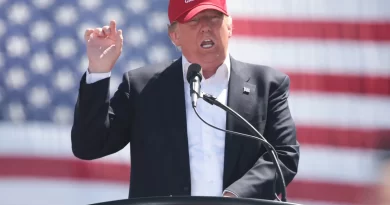Election Fraud Conspiracy Theories Are Already Thriving Online

Election workers in Bucks County, Pennsylvania, are not destroying mail-in ballots cast for former president Donald Trump. The Department of Defense did not issue a directive last month giving US soldiers unprecedented authority to use lethal force against Trump supporters who riot if the former president loses next week. And no, 180,000 Amish people did not register to vote in Pennsylvania—given there are only 92,600 Amish living in the state, including minors. Ron DeSantis never said that Florida would not use Dominion Voting machines in next week’s election. And municipalities in California are not allowing noncitizens to vote in this year’s presidential elections.
These are just a small sample of the flood of voting-related disinformation narratives that are being seeded and spread on social media platforms like X, Instagram, and Facebook in the build up to November 5.
The election denial movement never left, and it’s bigger than ever.
In the weeks before the 2020 vote, Trump and his allies had already begun to spread claims that the election would be stolen, but those allegations were vague and unorganized. Over the past four years, however, a well-funded network of election denial groups across the US have worked tirelessly to marshal their supporters and drum up conspiracy theories about voting machines flipping votes in the middle of the night, votes being shredded by the bagful, and “mules” stuffing drop boxes with ballots.
These conspiracy theories are being shared by right-wing election denial networks, the Trump campaign, and Russian propaganda groups. With a week left to go before the historic vote, fully formed conspiracy theories about threats to voting are being pushed to audiences that have been primed to believe everything they hear.
Many of these narratives are spreading virtually unchecked on social media platforms like X, Instagram, and Facebook, where those in charge have all but abdicated their responsibility to fact-check information around one of the most critical votes in US history—and have also made it harder for everyone else to see what is going on.
“What worries me most about this year is that we have a much more opaque window into the penetration of these lies, no matter where they come from,” says Nina Jankowicz, the former Biden administration disinformation czar who is now CEO of the American Sunlight Project. “Social media platforms have by and large stopped moderating such content, and just as worryingly have cut off researcher access to data streams that allowed us to objectively report on the scale of these campaigns, all due to political pressure on disinformation researchers and social media platforms.”
So when voters in Oregon heard earlier this month that the state’s Democratic secretary of state, LaVonne Griffin-Valade, had removed Trump and his running mate, JD Vance, from her website, they believed it was part of a plan to undermine Trump. The narrative was boosted by right-wing influencers and Trump supporters on platforms like X and Instagram and gained so much traction that Griffin-Valade’s office was forced to shut down its phone lines.
The reality is that the Trump campaign had decided not to provide a statement to Oregon’s Online Voter’s Guide, unlike the Harris campaign, which is why the vice president’s name was on the guide.
“Society as a whole is much less equipped to be proactive in the face of election lies,” says Jankowicz.
Similar conspiracy theories about down-ballot races have spread across the country. “It may not be altogether surprising, but it is striking that we have already seen election fraud narratives reminiscent of those we saw four years ago,” Sam Howard, NewsGuard’s politics editor, tells WIRED. “A baseless claim about machines switching votes started spreading in Tarrant County, Texas, on the first day of early voting. A similar false narrative about vote-switching took off during the first week of early voting in Georgia. The narrative in Georgia even involved Dominion Voting Systems.”
Last week, a viral video emerged claiming to show election workers in Bucks County, Pennsylvania, destroying mail-in ballots cast for former Trump, the very behavior that pro-Trump networks have spent years claiming happened in 2020.
Days after the video went viral, the FBI, the Office of the Director of National Intelligence, and he Cybersecurity and Infrastructure Security Agency issued a joint statement saying they had determined that the video was part of Russia’s efforts to influence the outcome of the election.
“This Russian activity is part of Moscow’s broader effort to raise unfounded questions about the integrity of the US election and stoke divisions among Americans,” the agencies said. “In the lead-up to election day and in the weeks and months after, the [intelligence community] expects Russia to create and release additional media content that seeks to undermine trust in the integrity of the election and divide Americans.”
Many of these new conspiracy theories about voter and election fraud have emerged from activists at a local level, whose accounts are then amplified by the coordinated network of election denial groups that have emerged in the wake of the 2020 election. These groups have continued to grow and establish strong connections to other national groups run and supported by some of the powerful figures in the conservative world.
The Election Integrity Network, an election denial group run by former Trump adviser Cleta Mitchell, has spent months holding online seminars to push disinformation around voter rolls and the baseless claim that millions of illegal immigrants will vote in the election. In the days ahead of the election, the group has produced a social media posting guide for its members on the best tactics to get these messages to the widest audience possible.
“Be SASSY but don’t say anything on social media you wouldn’t say in front of your grandma,” the guide’s authors write, adding that the best time to post is between 10 am to 4 pm on a weekday. “ALWAYS use graphics—and brains love faces.”
The guide, reviewed by WIRED, points users to mainstream platforms like Facebook and X, as well as fringe pro-Trump networks like Truth Social, Gettr, and Rumble.
True the Vote, an election denial group that pushed the bogus “ballot mules” conspiracy in 2020, even created its own social media platform that is dedicated to sharing election fraud conspiracy theories.
The Heritage Foundation, a group which has been at the forefront of election denial content in recent years, has been paying for ads on X to promote an ebook called 5 Shocking Cases of Election Fraud, which seeks to further undermine trust in elections by citing alleged fraud cases in Pennsylvania, Connecticut, Indiana, and California.
The proliferation of disinformation has helped create a fragmented information ecosystem where voters can find “proof” for almost any election-related conspiracy. And tech companies and their refusal to adequately moderate their platforms has made the situation much worse.
“This has created an environment where anyone can find content online that proves their beliefs to be true, no matter if it’s rooted in reality or not,” says Nicole Gill, the cofounder and executive director of Accountable Tech. “The public has fewer options to anchor themselves in truth and reality, and there’s no denying that Big Tech absolutely played a role in that.”

